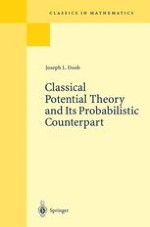2001 | OriginalPaper | Buchkapitel
The Dirichlet Problem for Relative Harmonic Functions
verfasst von : Joseph L. Doob
Erschienen in: Classical Potential Theory and Its Probabilistic Counterpart
Verlag: Springer Berlin Heidelberg
Enthalten in: Professional Book Archive
Aktivieren Sie unsere intelligente Suche, um passende Fachinhalte oder Patente zu finden.
Wählen Sie Textabschnitte aus um mit Künstlicher Intelligenz passenden Patente zu finden. powered by
Markieren Sie Textabschnitte, um KI-gestützt weitere passende Inhalte zu finden. powered by
The class of relative harmonic functions is suggested by the following trivial remark. Let (D, OC (M, p)D) be a measurable space, and suppose that to each point ξ of D is assigned some set (perhaps empty) {μα (ξ, ·), α ∈ Iξ} of probability measures on D. Call a function generalized harmonic if it satisfies specified smoothness conditions and if 1.1$$ v(\zeta ) = \int_D {v(\eta ({\mu_{\alpha }}(} \zeta, d\eta ) = {\mu_{\alpha }}(\zeta, v) $$ for ξ in D and α in Iξ. For example, if D is an open subset of ℝN, if for each ξ the index α represents a ball B of center ξ with closure in D, if Iξ is the class of all such balls, and if μB(ξ, v) is the unweighted average of v on ∂B, then the class of continuous functions on D satisfying (1.1) is the class of harmonic functions on D. Going back to the general case, suppose that h is a strictly positive generalized harmonic function and define μhα(ξ, ·) by 1.2$$ \mu_{\alpha }^h(\zeta, A) = \int_A {h(\eta )\frac{{{\mu_{\alpha }}(\zeta, d\eta )}}{{h(\zeta )}}} $$
